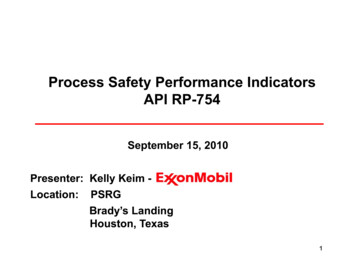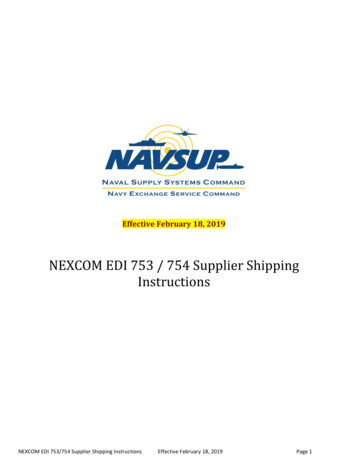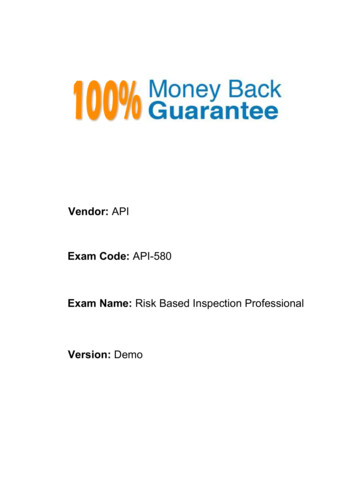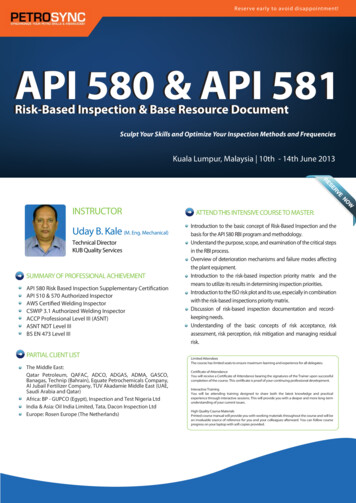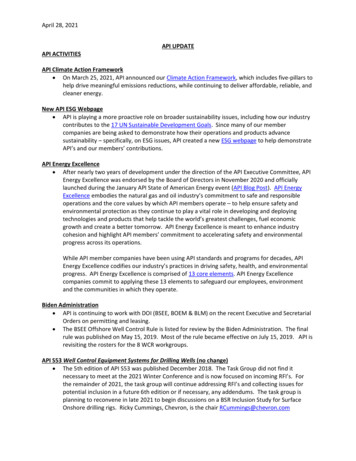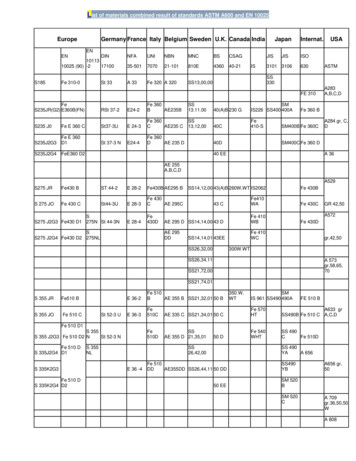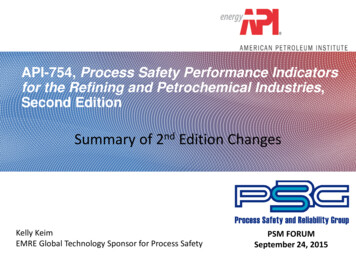
Transcription
API-754, Process Safety Performance Indicatorsfor the Refining and Petrochemical Industries,Second EditionSummary of 2nd Edition ChangesKelly KeimEMRE Global Technology Sponsor for Process SafetyPSM FORUMSeptember 24, 2015
Outline of This Presentation– Background– Summary of Second Edition Key Revisions: ScopeDefinitionsTier 1 Process Safety Event (PSE) RevisionsTier 2 Process Safety Event (PSE) RevisionsReporting Performance IndicatorsInformative Annexes– Reference Summary List of Revisions2
API-754, Process Safety Performance Indicators for the Refining andPetrochemical Industries, Second EditionBACKGROUND3
Background Information– Process to revise API-754 for Second Editioninitiated 2013– Broad solicitation of comments for Second Edition– Three significant issues identified: Direct cost value for fire/explosion Tier 1 PSE criteria( 25k v. 100k) Convert to Tier 1 and Tier 2 material release thresholdquantities based on Global Harmonized System (GHS)criteria Require mandatory use of a Severity Weighting tablefor Tier 1 PSEs4
Three “Big” Issues andPrevious Voting Results Three Significant Issues Previously Vetted viaDocumented Vote in Fourth Quarter 2014.1. 25k or 100k Tier 1 direct cost limit for fire orexplosion damage. Result: Super majority “approved” increase to 100k.2. Mandatory or optional use of Tier 1 severityweighting. Result: Mandatory use did not reach super majority(“rejected”).3. Tier 1 and Tier 2 threshold release categories andquantities (GHS v. non-GHS). Result: Super majority “approved” non-GHS option.5
API-754, Process Safety Performance Indicators for the Refining andPetrochemical Industries, Second EditionSUMMARY OF KEY REVISIONS:SCOPE6
1.2 Applicability “This recommended practice applies to the responsible party. Atcollocated facilities (e.g., industrial park), this recommendedpractice applies individually to the responsible parties and not to thefacility as a whole.” Responsible party defined as:“The party charged with operating the facility in a safe, compliant, and reliable manner isthe responsible party. In some countries or jurisdictions, the responsible party may be calledthe ‘duty holder’ or the party with regulatory reporting responsibility.”“Note: The responsible party is determined prior to any process safety event. Theresponsible party could be the facility owner or the facility operator depending upon therelationship between the two. Is the owner or the operator responsible for theperformance of the facility? Who is responsible for developing and implementingprevention programs? Who is responsible for performing the investigation andidentifying and implementing corrective action following a process safety event?).”7
Responsible Party: Example 1 Scenario: The facility experienced a Tier 1 PSE. The facilityis owned by Company A, but is operated by Company B.Who is the responsible party, who should count the PSE? Response: The answer depends on the nature of thecontract between the two parties. As the contract operator,does Company B also have responsibility for theperformance of the facility (i.e., In this case would they beexpected to perform the investigation and identify andimplement corrective action?). If ‘yes’, Company B is theresponsible party and they would record the PSE. If ‘no’and Company B is simply acting upon the instructions ofCompany A, then the Company A is the responsible partyand they would record the PSE.8
Responsible Party: Example 2 Scenario: A third-party tank truck operator begins filling his tankerat an unstaffed loading rack. The belly valve of the tanker truck wasleft open and when the operator disconnected the loading hose, aTier 1 quantity of flammable liquid was spilled. This is a Tier 1 PSEsince the LOPC occurred while disconnecting from the process (i.e.,the loading rack). Although the third-party tank truck operator hasan obligation to follow the operating procedures (i.e., close thebelly valve before disconnecting the loading hose), he is not theoperator of the facility and therefore he is not the responsibleparty. Response: The Company that owns or operates the loading rack isthe responsible party. The Company establishes the operatingprocedures, installs prevention measures, authorizes third-partiesto use the facility, etc.9
1.2 b) and c), Transfer Operations Clarification added to include within scope of API-754 the act of“connecting and disconnecting” to a process for the purpose of feedstocktransfer. Clarification added that “active staging” is not considered on-site storage.– “Active staging” defined as “Truck or rail cars waiting to be unloaded wherethe only delay to unloading is associated with physical limitations with theunloading process (e.g., number of unloading stations) or the reasonableavailability of manpower (e.g., unloading on daylight hours only, unloadingMonday - Friday only), and not with any limitations in available volume withinthe process.”– Example: Two chlorine railcars have been delivered to the facility. One isconnected to the process and the other is staged at the unloading rack but isnot connected to the process. While at the unloading rack but not connectedto the loading rack, the second railcar develops a leak and 6 lb is released inless than an hour. This is not a PSE since truck and railcars are expresslyexcluded unless connected to the process or being used for on-site storage.Active staging while waiting to unload is not considered storage.12
1.2 j), Positively IsolatedNew Construction Added following event as falling outside of thescope of API-754:– j) new construction that is positively isolated (e.g.,blinded or air gapped) from a process prior tocommissioning and prior to the introduction ofany process fluids, and that has never been part ofa process.13
New Construction: Example Scenario: As part of a new construction project,equipment was being hydrotested using potable waterwhen a 2” ball valve suddenly became disconnected.The hose whipped and struck a worker in the head andcaused his death. Is this a Tier 1 PSE? Response: A hydrotest using potable water for newconstruction is not considered a “process”; therefore,this tragic event is not a PSE. It is an occupationalsafety related fatality and an appropriate investigationshould be conducted to prevent a recurrence.14
API-754, Process Safety Performance Indicators for the Refining andPetrochemical Industries, Second EditionSUMMARY OF KEY REVISIONS:TERMS AND DEFINITIONS15
3.1, Definition of Process andActive Warehouses Definition of “process” revised to include “activewarehouse” as follows:“Production, distribution, storage, utilities, or pilot plant facilities used in the manufacture ofpetrochemical and petroleum refining products. This includes process equipment (e.g. reactors,vessels, piping, furnaces, boilers, pumps, compressors, exchangers, cooling towers, refrigerationsystems, etc.), storage tanks, active warehouses, ancillary support areas (e.g. boiler houses andwaste water treatment plants), on-site remediation facilities, and distribution piping under controlof the Company.” Definition of “active warehouse”:“An on-site warehouse that stores raw materials, intermediates, or finished products used orproduced by a refinery or petrochemical manufacturing process.”“From a process perspective, an active warehouse is equivalent to a bulk storage tank. Ratherthan being stored in a single large container, the raw materials, intermediates, or finished productsare stored in smaller containers (e.g., totes, barrels, pails, etc.”16
API-754, Process Safety Performance Indicators for the Refining andPetrochemical Industries, Second EditionSUMMARY OF KEY REVISIONS:TIER 1 PERFORMANCE INDICATOR17
5.2, Tier 1 Indicator Definition and Consequences:Precautionary Community Response Officially declared community evacuation or community shelter in place:– Clarified this consequence includes “precautionary evacuation or shelter-inplace” and would be a Tier 1 PSE. Precautionary defined as:“A measure taken from an abundance of caution.”“For example, a company may require all workers to shelter-in-place in response toan LOPC independent of or prior to any assessment (e.g., wind direction, distancefrom the LOPC, etc.) of the potential hazard to those worker.”“For example, a recognized community official (e.g., fire, police, civil defense,emergency management) may order a community shelter-in-place, evacuation, orpublic protective measure (e.g., road closure) in the absence of information from acompany experiencing a process safety event, or ‘just in case’ the wind directionchanges, or due to the sensitive nature of the potentially affected population (e.g.,school children, the elderly).”18
5.2, Indicator Definition and Consequences: Fire orExplosion Damage Fire or explosion direct cost criteria raisedfrom 25,000 to 100,000 for triggering Tier 1PSE.– Note: PSE Tier 2 criteria ( 2,500) did not change,therefore 25,000 to 99,999.99 direct cost eventswill still fall within Tier 1/Tier 2 tracking andreporting.– Direct cost definition modified for consistency inapplication.19
5.2, Indicator Definition and Consequences: Fire orExplosion Damage Direct Cost Direct cost defined as:“Cost of repairs or replacement, cleanup, material disposal, and acute environmental costassociated with a fire or explosion. Direct cost does not include indirect costs, such asbusiness opportunity, business interruption and feedstock/product losses, loss of profits dueto equipment outages, costs of obtaining or operating temporary facilities, or costs ofobtaining replacement products to meet customer demand. Direct cost does not include thecost of repairing or replacing the failed component leading to LOPC if the component is notfurther damaged by the fire or explosion. Direct cost does include the cost of repairing orreplacing the failed component leading to LOPC if the component failed due to internal orexternal explosion or overpressure.” Acute environmental cost replaced “environmental remediation”. Acute environmental cost defined as:“Cost of short-term cleanup and material disposal, associated with an LOPC with off-siteenvironmental impact.” Cost of emergency response removed from direct cost definition givenvariation and inconsistency.20
5.2, Indicator Definition andConsequences: Relief Discharges For clarification, added safety instrumentedsystem and other engineered depressuringdevices to this consequence for Tier 1 PSEconsideration as follows:“a pressure relief device (PRD), safety instrumentedsystem (SIS), or other engineered depressuring devicedischarge, of a quantity greater than or equal to thethreshold quantities in Table 1, to atmosphere whetherdirectly or via a downstream destructive device thatresults in one or more of the following fourconsequences:”21
5.2, Indicator Definition andConsequences: Relief Discharges For discharges resulting in shelter-in-place,evacuation and public protective measures,clarified treatment of “precautionary”. The following consequences would be consideredTier 1 PSEs:– “an on-site shelter-in-place or evacuation, excludingprecautionary shelter-in-place or evacuation;”– “public protective measures (e.g. road closure)including precautionary public protective measures.”22
5.2, Indicator Definition and Consequences: LabAnalysis and Safety Data Sheets (SDSs) Clarification Added for Use of Lab Analysisand/or SDSs:“Note: In determining the Threshold ReleaseCategory, a Company may choose to use either theproperties of the released material based uponlaboratory analysis at the time of release, or theproperties documented in a safety data sheet.Companies should be consistent in their approach forall LOPC’s.”30
5.2 Table 1, Tier 1 Material ReleaseThreshold Quantities (TQs)Key Changes in TQ Table andCriteria:1. Indoor release quantitiesreduced.2. “Initial” changed to“Normal”.3. Removed word “strong”.4. Removed word “moderate”.5. Added reference todefinitions.6. Added UNDG Class 2,Division 2.2 (non-flammable,non-toxic gases) excludingair, recognizing potential forasphyxiation.12345631
5.2 Table 1, Tier 1 Material Release ThresholdQuantities (TQs) Notes: Use of Packing Groups Closes a potential “loophole” by clarifying thePacking Group is used when other hazards are nototherwise expressed/known:“In determining the Threshold Release Category for a material, oneshould first use the toxic (TIH Zone) or flammability (Flash Point andBoiling Point) or corrosiveness (Strong Acid or Base vs. ModerateAcid or Base) characteristics. Only when the hazard of the materialis not expressed by those simple characteristics (e.g. reacts violentlywith water) is the UNDGL Packing Group used.”32
5.4, Optional Tier 1 PSESeverity Weighting Used CCPS Severity Weighting as starting point. Modified weighting and included in Annex D. Severity consequence categories:–––––Safety/Human HealthDirect Cost from Fire/ExplosionMaterial Release Within Any 1-Hr PeriodCommunity ImpactOff-Site Environmental Impact Useful in communicating actual loss impact of aPSE Tier 1 internally within the Company34
5.4, Optional Tier 1 PSESeverity Weighting: Annex D Table 4SeverityPoints Increasing Severity1 point 3 points 9 points 27 points Table 4 -- Tier 1 Process Safety Event Severity WeightingConsequence CategoriesDirect Cost from Fire orMaterial Release WithinSafety/Human Health aCommunity ImpactExplosionAny 1-Hr Period bInjury requiring treatment Resulting in 100,000 Release volume 1x Tier 1 Officially declared shelter-inbeyond first aid to anDirect Cost Damage TQ 3x outside ofplace or public protectiveemployee, contractor, or 1,000,000.secondary containment.measures (e.g., road closure) for subcontractor. (Meets the3 hours, ordefinition of a US OSHA Officially declared evacuation 3hours.recordable injury.)Days Away From Work injury Resulting in 1,000,000
API-754, Process Safety Performance Indicators for the Refining and Petrochemical Industries, Second Edition . Kelly Keim. EMRE Global Technology Sponsor for Process Safety. Summary of 2nd Edition Changes. PSM FORUM. September 24, 2015. Outline of This Presentation – Background – Summary of Second Edition Key Revisions: Scope Definitions Tier 1 Process Safety Event(PSE .File Size: 711KBPage Count: 37
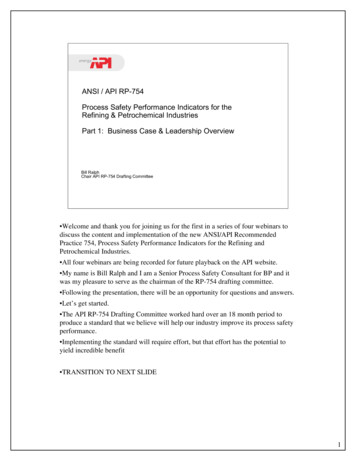
![API Ballot: [Ballot ID] – API 510 & API 570, Deferrals, Rev05](/img/5/api510andapi570deferralsrev5.jpg)
